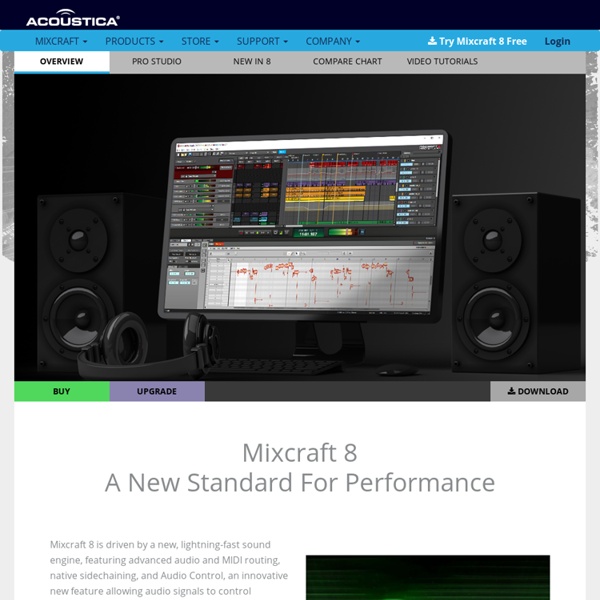



ProTools | Avid Collaborate in the cloud Easily share tracks and work on projects with anyone—anywhere. As if you’re all together in the same studio. Create, connect, and collaborate with talent around the world. Get the details Crank up your creativity and speed From powerful new loop-based music creation and trying ideas via Revision History, to timesaving workflows that simplify editing and post production, Pro Tools enables you to create at the speed of your imagination—without limits. See what's new Access Pro Tools in more ways than ever You now have more choice in how you acquire and use Pro Tools. See your purchasing options Experience great power You've got a ton of ideas. See what more you can achieve with the advanced toolset. Check out more new features Elevate your sound How can you make your mixes really stand out? Get the sounds of natural sounding spaces and classic stompbox effects. See all bonus plug-ins
Mixcraft Mixcraft is a multitrack recording application for Windows. The software functions as a Digital Audio Workstation (DAW), MIDI sequencer, virtual instrument host, non-linear video arranger, and as a music loop remix program. The current version of Mixcraft is version 6. Version 6 introduced many new features over the previous version 5.2, including: Thousands of new loops, for a total of 6000 loopsAbility to import user loops into the loop libraryAn updated interface, including an enhanced mixerNew video editing features, including scrolling text and automatable effectsReWire hostingSupport for VST instruments with multiple outputsSubmix tracksOutput busses, which can be routed to multiple audio hardware outputsPunch in/punch out recordingMultiple lanes per trackA built in chromatic tuner on every track,Drum mapsMIDI control surface supportRoute MIDI data to audio effectsLoop recordingEffects chains, including dozens of preset effects chains Major features[edit] Awards[edit] History[edit]
The Development of the Descriptive Video Service Collection: Video and Captioning B.J. Cronin; S.R. King ABSTRACT: Television is an important means of obtaining information and sharing in the culture of this society. Because television is both a visual and an aural medium, blind and deaf people were, for many years, shut out of a fully satisfying experience with television. In January 1990, WGBH, the public television station in Boston, launched Descriptive Video Servicesm, (DVS®) a free, national broadcast service that makes television programs accessible to blind and visually impaired persons. The process of adding description to a television program involves writing the descriptions for insertion during pauses in the dialogue and then narrating the description "to picture" in a production studio. History of DVS® The idea of audio description for visually impaired people is not new. In 1985, with the advent of stereo television broadcasting, WGBH began exploring possible applications of this new technology. The Local Test Barry J.
Studio One | PreSonus Get tactile control. The StudioLive CS18AI is the first surface designed by PreSonus to control Studio One. Connected with a single Ethernet cable, you get 18 touch-sensitive moving faders, dedicated Fat Channel controls, markers, transport, scribble strips, filter DCA mix layers, and more. The CS18AI is also a 4 x 2 interface, providing additional I/O. Short on space or just want to get away from your desk? The rugged FaderPort also provides the essential controls you need, including one touch-sensitive moving fader, in a compact space. Studio One is also compatible with, and offers presets for, the most popular Mackie Control / HUI control surfaces and all MIDI controllers. close Bridges Web - Memories In A Snap MTT16: Creative composition projects using music technology | Midnight Music In this episode: What types of creative music tech projects can I do with my middle or senior school students? I share my favourites which include film scoring, video game composition, the science of sound, digital storytelling, song writing, recording covers and more. Listen to the episode here (or on your favourite podcast app): Resources and links mentioned Episode sponsor: A big thank you to this episode’s sponsor SmartMusic – the learning platform that allows teachers to connect with students as they practice. Learn more about SmartMusic here. Resources and links mentioned: 1. 2. 3. 4. 5. 6. 7. 8. 9. 10. 11. 12. 13. Midnight Music Community: special rate for MTT podcast listeners The Midnight Music Community (MMC) is an online space for music teachers interested in learning more about music technology. Access the special rate for podcast listeners here. Did you enjoy today’s episode? If you enjoyed today’s show, please share it with your friends and colleagues.
Biteslide Research, create, and present school projects online Cool Online Instruments and Games for the Music Classroom | Midnight Music Cool Online Instruments and Games for the Music Classroom There’s a growing list of fantastic online musical “instruments” and games that are a great resource for teachers in the music classroom. They can be effective when used with students on laptops and desktops, but they also work really well in a one-computer classroom with a large screen or better still, an interactive whiteboard. Get Creative with Pentatonic Improvisation Tone Matrix by Andre MichelleAdd (or remove) sounds by clicking on a box on the gridPress the spacebar to clear the whole grid and start againBased on the pentatonic scaleAQWERTYONTurn your computer keyboard into a musical keyboardPlay along with your choice of Youtube videosSelect your scale type, mode, and root, and have hours of fun! Online Instruments The next few online “instruments” are a bit of fun and would work really well with an interactive whiteboard. Online Music Games 9. 10. 11. 12. Online Drum Sequencers Download a copy of this list
Mentor Mob Free And Social Learning